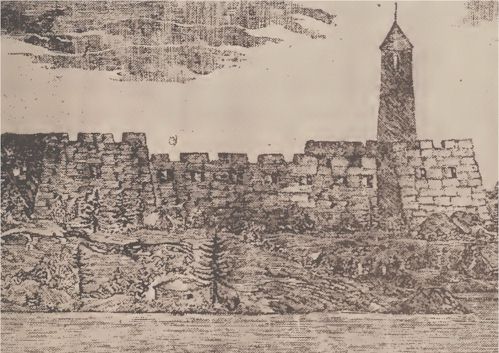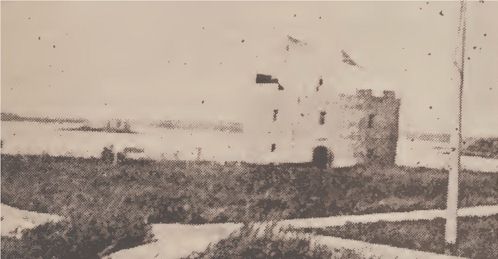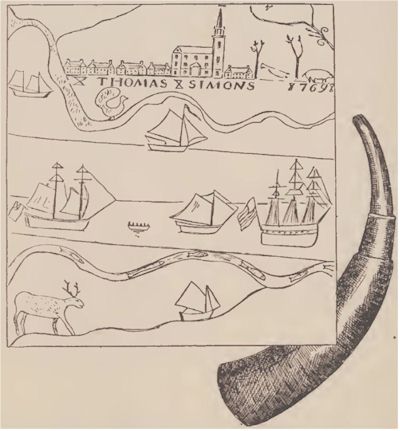Four Forts of Pemaquid
Forts, Pirates and Indians!! Are there
any three words which would grip the average boy harder and hold
before him better the Great Adventure? Where were these four
wonderful forts, is the first question. If you will follow the
jagged coastline of Maine from Portland to beyond where the
Damariscotta River flows into the ocean, you will find a long
point of land marked Pemaquid, at the south end of which stands
a noted lighthouse. This point is about three miles long and
extends to the mouth of the Pemaquid River where that meets
Johns Bay and forms the inner harbor and nearly surrounds a
small peninsula of about eighteen acres upon which the four
forts have been erected. Here, too, were found the buried paved
streets, of which no one knows the history, and hundreds of
walled cellars, which have been mostly filled up. That little
spot holds more history to the square foot than any town in
Maine. This point forms the east side of the great bay, which
with its island in the center, was named by the celebrated Capt.
John Smith of Pocahontas fame when he was sent to this country
by the King of England in 1614, six years before the arrival of
the Pilgrims at Plymouth. A few men had come there and built
rough cabins for a bare shelter while they traded in fish and
furs, bartered from the Indians in exchange for beads and bits
of finery. Later other men came really to settle there; to build
small houses; to farm the land as well as to engage in fishing.
The Indians, at first friendly, had been
brought into the troubles between England and France, who in
those days were always fighting each other. For the most part
the tribes of Maine sided with France in the quarrel. The
English had cheated them a bit more and had been much more cruel
to them and now were trying to drive them away from the coast to
the inland forests. The Indians, angered by these acts, often
attacked small groups of settlers. Thus the pioneers at Pemaquid
found they must have some protection against wandering bands of
Indians, so they built a house called a block house. It was
round without windows, but with loop-holes through which to put
the muzzle of their muskets to fire on the foe. It was large
enough to hold all the men, women and children of the
settlement, though of course they were crowded. Around it was a
high fence called a stockade which enclosed a yard where there
was a well in case of siege.
Ten years after this fort was built on
what is now called Fort Rock, while Captain Shurt was in
command, there was an attack. Remember it was built to keep away
the Indians and who do you suppose made that attack! Did you
ever hear of Dixy Bull? All along our Maine coast were little
schooners gathering up the fish caught and cured by the
fishermen and the furs sold by the Indians and taking them
either to Plymouth Colony or to the Mother Country (England).
Every little while a pirate ship flaunting its black flag would
sail along the shores, making an attack sometimes on a fishing
boat and sometimes on the poor settlers. One of the boldest of
these pirates was the famous Dixy Bull and in 1632 he swooped
down on Shurt's fort, plundered it and plundered all the farms
near. He was the leader of the whole pirate crew and lost but
one man in this attack.
 |
| Old Fort Frederic, Pemaquid |
 |
| Fort at Pemaquid as it Looks
Today |
When Gov. Winthrop at Boston learned of
Bull's wicked deeds, he sent four small vessels with forty men
aboard and others joined in the pursuit, determined to drive all
pirates from the Maine coast. However, this time Dixy was quick
enough to escape. Some years after he was captured and taken to
England where he was severely punished.
The second fort at Pemaquid was called Fort Charles. It was
built in 1677 under the direction of Sir Edmond Andros, then
colonial governor of New York. Like the first fort, it was built
of wood, two stories high, with a stockade or high fence around
it. It also was built to keep the Indians away.
On Penobscot Bay at a place called
Pentagoet (Castine) lived a Frenchman, Baron Castin, who owned a
trading house there with a fort and Catholic Mission. In 1689
France and England were not in open war but were constantly
making raids against each other. The year before, Andros had
pillaged Castings house and now the Baron plotted revenge on
Andros' fort at Pemaquid. He easily secured the help of the
Indians because he had married the pretty young daughter of the
celebrated chief, Madockawando, which made him a member of their
tribe.
Castin sent three canoes ahead to see
that the way was clear and the plan was for them to wait two
leagues from the fort, probably at what is now Round Pond. After
landing, they marched, with great caution, toward the
settlement. On their way, they took three prisoners, from whom
they learned that about 100 men were in the fort and village.
One of the three captives was named Starkey and, in exchange for
his own liberty, he told the Indians that at that particular
time only a few men were in the fort, as Mr. Giles, with a party
of fourteen men, had gone up to his farm to work, three miles up
the Pemaquid River. The Indians, thereupon, divided their little
army. Part, going up to the Falls, killed Giles; the rest
started for the fort and took their position between the fort
and the village, so as to cut off the men as they came in from
the fields where they were at work.
The firing between the Fort and the
Indians ceased only with darkness, when the besiegers summoned
the commander to surrender the fort and received as a reply from
someone within that "he was greatly fatigued and must have some
sleep."
At dawn, the firing on both sides was
renewed; but soon the firing from the fort ceased and Lieut.
James Weems, the commander, agreed to surrender. Terms were
made, the commander soon came out, at the head of 14 men, all
that remained of the garrison. With them came some women and
children with packs on their backs.
The terms of surrender included the men
of the garrison and the few people of the village who had been
so fortunate as to get into the fort, with the three English
captives who had previously escaped from the Indians. They were
allowed to take what-ever they could carry in their hands and to
depart before, from Capt. Padeshall, who was killed as he was
landing from his boat. All the men and women and children of the
place who had not been in the fort and had not been killed in
the fight, were compelled to leave with the Indians for the
Penobscot River. They made the passage, some in birch-bark
canoes and the rest in two captured sloops. The whole number of
captives thus taken was about 50; but how many were killed no
one knows exactly. The number of soldiers killed was about 16.
Weems himself was badly burned in the face by an accidental
explosion of gunpowder.
One of the captives was Grace Higiman
and the following story of her experiences in captivity will
interest you.
"On the second day of August, 1689, the day Pemaquid was
assaulted and taken by the Indians, I was there taken prisoner
and carried away by them, one Eken by name, a Canadian Indian,
pretending to have a right to me, and to be my master. The
Indians carried away myself and other captives (about 50 in
number) unto the Fort of Penobscot. I continued there for about
three years, removing from place to place as the Indians
occasionally went, and was very hardly treated by them both in
respects of provisions and clothing, having nothing but a torn
blanket to cover me during the winter seasons, and oftentimes
cruelly beaten. After I had been with the Indians three years,
they carried me to Quebeck and sold me for forty crowns unto the
French there who treated me well, gave me my liberty, and I had
the King's allowance of provisions, as also a room provided for
me, and liberty to work for myself. I continued there for two
years and a half."
In 1692 after Sir William Phips, the
first Colonial Governor of Massachusetts, of which Maine was
then a part, had captured Port Royal, he came to Pemaquid to
arrange to have a strong fort built which should maintain the
rights of England to that eastern territory and prevent attack
of the Indians on the western settlements. He knew this part of
Maine well as his boyhood had been spent here. The new fort was
built of stone, about 700 feet square. It had fourteen mounted
guns, about half of them 18 pounders; the sea wall was 22 feet
high with a round tower somewhat taller toward the west, built
around the great rock at the west corner which the Indians had
used to capture Fort Charles; two hundred cart-loads of stone
were put into the building; sixty men were left for its defense.
This fort was a great annoyance to the Indians as it was on
their direct line of travel on the sea coast.
Another trouble was arising between two
French frigates and two British ships sent out to capture them.
D 'Iberville, commander of the French, allied himself with Baron
Castin who brought with him two hundred Penobscot Indians. D
'Iberville had one hundred more aboard his ships, while Villieu,
a French officer with twenty-five French soldiers, joined them.
The three ships made sail for Pemaquid, the Indians covering the
distance in their canoes.
The next day, August 14th, they ordered
the fort to surrender. Its captain, Pasco Chubb, a born fighter,
sent back word. "If the sea was covered with French vessels and
the land with Indians, I would not surrender."
During the night the French came ashore
with guns and the next day from a high bluff began throwing
bombshells inside the fort. The soldiers and the people gathered
within the fort probably had the surprise of their lives. Here,
then, were bomb-shells, brought into use, probably, for the
first time in the history of warfare in this country. It is
certain the English had no bomb-proof covers for the protection
of those within the fort. Consternation and despair came with
this new shrieking element of destruction; for it seemed that
they were gathered like a helpless flock of sheep, to perish
together.
Then Castin sent a letter into the fort,
which informed them that if they would surrender, they should be
transported to a place of safety, and receive protection from
the savages; but if they were taken by assault, they would have
to deal with the Indians and must expect no quarter.
Terms of surrender were agreed upon by
the officers of the fort. All marched out and were taken to one
of the islands nearby for protection from the Indians while
Villieu, with sixty French soldiers, took possession of the
fort. They found an Indian confined with irons in the fort, who
had been a prisoner since the previous February. He was in
pitiable condition.
The fourth fort was named Fort Frederic,
in honor of the young Prince of Wales. It was built in the
spring of 1729, by David Dunbar, who came to Pemaquid from
England for that express purpose, bringing his family with him.
He had a royal commission as governor, from the British
government, authorizing him to rebuild the fort, as the
Massachusetts government had failed to do it.
Many bloody tales of warfare might be
related, concerning Fort Frederic, stirring tales of adventures
and records of trials endured by these hardy border settlers.
One of the tales handed down, relates how the Indians, on one of
their unexpected visits, found a mother with her two daughters,
picking berries some distance from the fort. All fled for
protection toward the fort and the mother and the older girl
reached it, barely escaping with their lives. The younger girl,
not more than eleven years old, was seized and scalped. And now
comes the remarkable part of the story. The savages threw the
little girl, whom they supposed to be dying, on a pile of rocks,
where the sun shone directly down on her unprotected head. The
kindly, healing rays of the sun quickly dried the blood and
stopped any further flow and her life was saved. And so she
lived to grow up, one of the very few who ever survived the
scalping knife.
When the French and Indian war closed
with the fall of Quebec, in 1759, the usefulness of the fort was
ended. After a few years of peace, in 1762, the great cannon
were carried away to Boston.
When the Revolution began, April 19,
1775, Pemaquid people became alarmed and, in town meeting, voted
to tear down the old fort, so that the British could not use it
against them.
Today, near Pemaquid Beach, you may see
the ruins of the old fort, marked by the old Fort Rock of
Pemaquid, with the date of 1607 upon it. This is the date of the
landing of the Popham colonists, the first English people at
that place, August 8 and 10, 1607, thirteen years before the
landing of the Pilgrims at Plymouth Rock.
 |
| Indian Horn |
Horn presented by the Indians to the
commander of Fort Frederic. The accompanying sketch was carved
on the horn, and is supposed to picture historic scenes at
Pemaquid. The tall spired church as an emblem of English
worship, indicated a religious community; the water sketching of
the little river Pemaquid with varied navigation afloat,
indicated the commercial aptitude and business of the Fort
Frederic Settlement in the early period of English life there;
the turkey cock, fish and deer are indications of the resources
in game and the industries in furs and fisheries - fishery
predominating.
Fort Rock is now surrounded by the old
castle, restored on the original foundations and with most of
the original stone of which it was first built by Sir William
Phips in 1692. This foundation was discovered in 1893, in good
condition, after being buried and forgotten since the American
Revolution.
Here, also, is the old Fort House on its
beautiful peninsula, with its "field of Graves," the site of the
ancient capital of Pemaquid, with its paved streets, which had
been buried for centuries and only discovered by accident, to
remind us of a people long ago forgotten.
Note. - The material in this story is
from Cartland's "Twenty Years at Pemaquid."
|
![]()
![]()